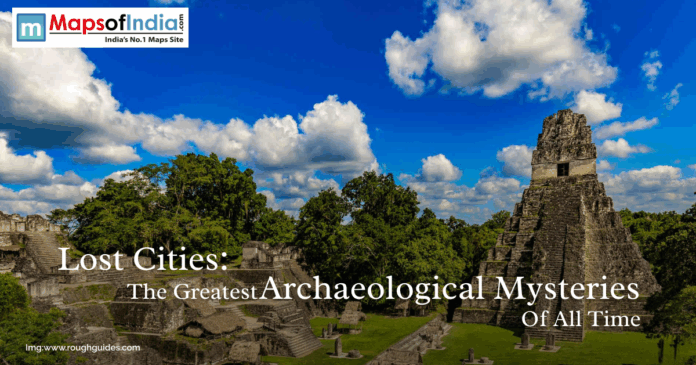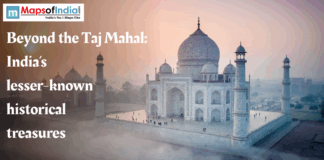Across the globe, hidden in deep jungles, deserts, and oceans, lie lost cities. These cities hold mysteries of enigmatic relics of ancient societies that captivate historians and adventurers alike. From India’s Mohenjo-Daro to the submerged Thonis-Heracleion in Egypt are well-known. These archaeological wonders spark questions about their rise, fall, and disappearance. Fueled by cutting-edge technology like LIDAR and recent discoveries, the quest to unravel these mysteries is reshaping our understanding of history. The movie industry is also fascinated with lost cities making movies around this for decades from Indiana Jones to the recently released Lost City of Z.
What Are Lost Cities?
Lost cities are ancient settlements which were abandoned or forgotten and then after centuries rediscovered through archaeology. There are various types of lost cities which range from planned cities like Mohenjo-Daro to mythical sites like Atlantis. Across the globe there are over 10,000 such lost cities have been discovered, with 20% in South Asia. There are various reasons for these cities to vanish like such as natural disasters, climate shifts, invasions, or economic collapse. Which ended up leaving behind artefacts and unanswered questions.
Lost cities have mystery and stories of human resilience. Rediscovery of these cities often after centuries reveals advanced technologies, cultures, and trade networks.
Iconic Lost Cities and Their Mysteries
Mohenjo-Daro, India
The lost site of Mohenjo-Daro was discovered in 1922 in modern-day Pakistan by archaeologist R.D. Banerji. This Indus Valley city which existed from 2600–1900 BCE is a UNESCO site.
This city had well well-structured grid layout and drainage systems rivalling modern urban planning, showcasing India’s ancient engineering prowess.
There is still a mystery surrounding the decline of the city. Why did its 40,000 inhabitants vanish? There are various speculations suggesting climate-induced drought and river shifts, but melted ceramics hint at a catastrophic event, possibly a flood or conflict.
Thonis-Heracleion, Egypt
The city of Thonis-Heracleion was discovered in 2000 by Franck Goddio and his team from the European Institute for Underwater Archaeology (IEASM). They found the lost city submerged 7 kilometres off the coast of Egypt in Aboukir Bay. This port city served as Egypt’s gateway in the 8th century BCE.
The significant discoveries in this city were artefacts like statues and coins that showed the existence of trade links with Greece. This can also be helpful to offer insights into Cleopatra’s era.
The mystery surrounding the sinking of this city still remains. Geoarchaeology study points to earthquakes and sea-level rise. But the sudden collapse remains in question.
Machu Picchu, Peru
Machu Picchu is a famous Inca citadel in Peru which was rediscovered and brought to the attention of the wider world by Hiram Bingham in 1911. Even though he is credited with the “discovery” that made this site world famous. But it’s important to note that the site was known to locals before his arrival. Bingham was led to the site by a local Quechua-speaking resident. This Inca city which existed in the 15th century CE, sits atop the Andes.
Its stone architecture and terraced agriculture highlight Inca ingenuity, drawing 1.5 million tourists annually.
The mystery around the disappearance of the city still remains. Was it a royal retreat or a sacred site? A report suggests a population of 5000, but its abandonment is possibly due to smallpox this remains unclear.
Ciudad Perdida, Colombia
The site was discovered by a group of local treasure hunters called Los Sepulvedas in 1972. This Tayrona city existed in 700 CE and predates Machu Picchu.
The Significance discovery in this site is its stone terraces and jungle setting reveal a sophisticated pre-Columbian society.
The Mystery of Why was it abandoned? It is still not solved. Some speculate that it is because of spiritual reasons but the real reason is unknown.
Amazonian Lost Cities, Bolivia
This site was discovered by using LIDAR scans technology. Archaeologist Heiko Prümers, along with a team from the German Archaeological Institute, were also instrumental in investigating the area and uncovering these sites. The findings were published in the journal Nature. This site dates back to 500–1400 CE.
These findings challenge assumptions about “primitive” Amazonian cultures, reshaping global archaeology.
Mystery around how dense cities thrive in a rainforest? It still remains. Research suggests advanced agriculture, but their collapse possibly due to climate shifts remains elusive.
India’s Lost Cities: A Closer Look
Dholavira, Gujarat
This site was discovered by archaeologist Jagat Pati Joshi in 1967-68. This Harappan city was in existence back into 3000–1500 BCE. This site is a famous UNESCO site.
It was an advanced civilisation known for its city planning, sophisticated waste management system and advanced architectural features.
Lothal, Gujarat
The ancient Harappan port city of discovery by S.R.Rao, an indian archaeologist in 1954, Lothal the city esteemed to have existed in 2400–1900 BCE.
The port city of Lothal has a well-preserved dockyard which is one of the world’s oldest ports. which showcase India’s ancient maritime prowess. It helps to connect the ancient Harappan civilisation to other civilisations.
Poompuhar, Tamil Nadu
This site has been studied and explored in combined efforts of the Tamil Nadu State Department of Archaeology (TNSDA) and the National Institute of Oceanography (NIO). Submerged ruins off Tamil Nadu’s coast are linked to the Chola era (300 BCE–300 CE). That lost city was discovered using sonar technology.
This city was a trade link with Southeast Asia highlight South India’s historical global connections.
Technological Advances Unlocking Mysteries
LiDAR and Remote Sensing
LiDAR stands for light detection and ranging. This is a remote sensing technology which uses laser light to measure distance to an object and create a detailed 3D model of that object. This technology has revolutionised archaeological discoveries revealing hidden structures under dense vegetation. In 2024 LiDAR technology was used to scan the Amazon uncovering 2,500 km of roads and 20 cities. In India, LiDAR mapping was used in Harappan sites in Haryana which helped to identify 500 new settlements.
AI and Data Analytics
In archaeology, data analytics is used to identify and map ancient sites, sometimes remotely, reducing the need for disruptive physical exploration. Computer vision algorithms and AI are utilised in archaeology to discover potential sites and study ancient artefacts and languages. AI-driven analysis of artefacts accelerates discoveries.
Underwater Archaeology
Sonar and submersibles are used to investigate submerged sites, structures, and artefacts, including shipwrecks, submerged settlements. This technology has helped to uncover submerged cities like Thonis-Heracleion and Poompuhar.
Challenges in Unravelling Mysteries
Environmental Threats
Climate change endangers sites. Rising sea levels threaten Poompuhar, while desertification impacts Dholavira. A 2024 Climate Risk study estimates 20% of UNESCO sites are at risk by 2050.
Looting and Vandalism
Illegal artefact trade, valued at $10 billion annually, depletes sites like Mohenjo-Daro. India’s Antiquities Act (2024) aims to curb this, but enforcement lags.
Deciphering Scripts
Undecoded scripts, like the Indus Valley’s, hinder understanding. AI progress is slow, with only 10% of symbols interpreted, per a 2024 Linguistics Journal.
Conclusion
Lost cities like Mohenjo-Daro, Thonis-Heracleion, and Machu Picchu are some of the human civilisation’s greatest mysteries. This city tells the stories of our lost history. In India sites like Dholavira and Poompuhar show the steps of our ancestors. This civilisation was advanced, had great technologies and best waste management system. Now developed technologies like LIDAR, AI, and sonar are helping to unlock many secrets which are held by these cities. These cities, though lost to time, continue to teach us, proving that the past is never truly gone.





